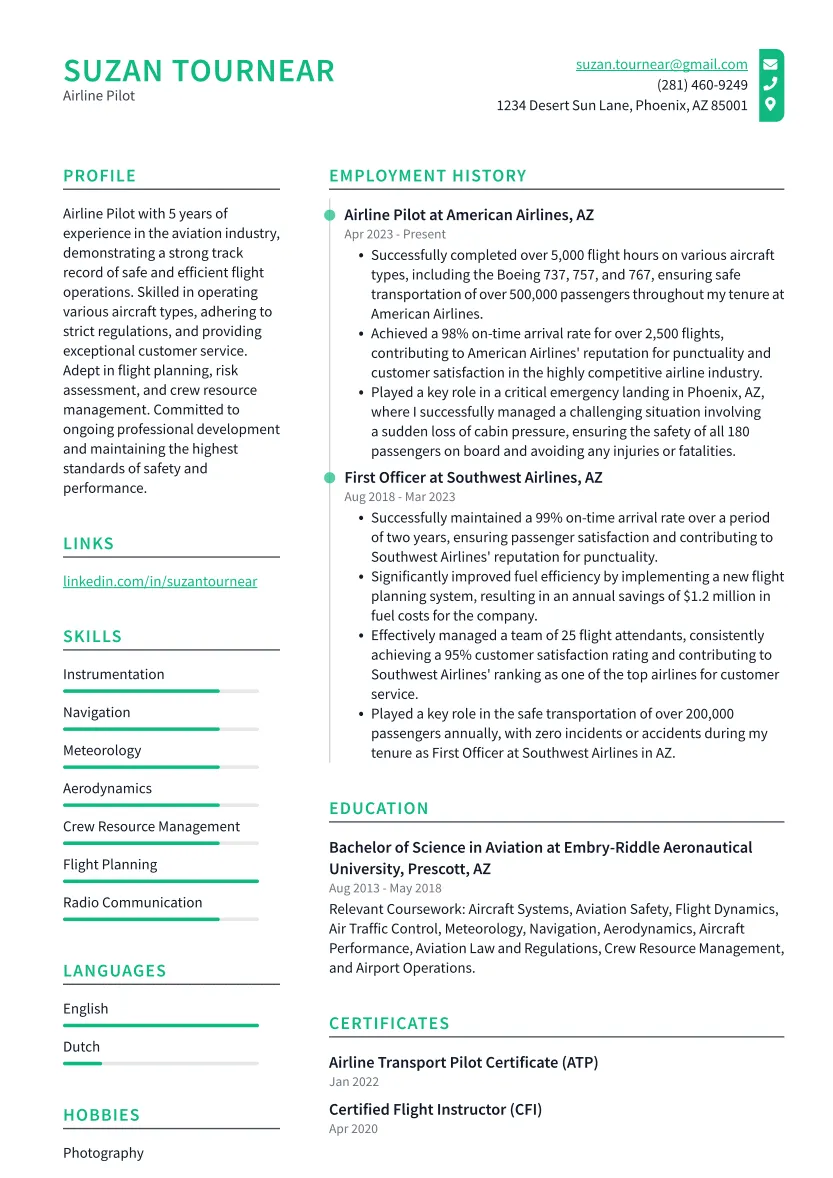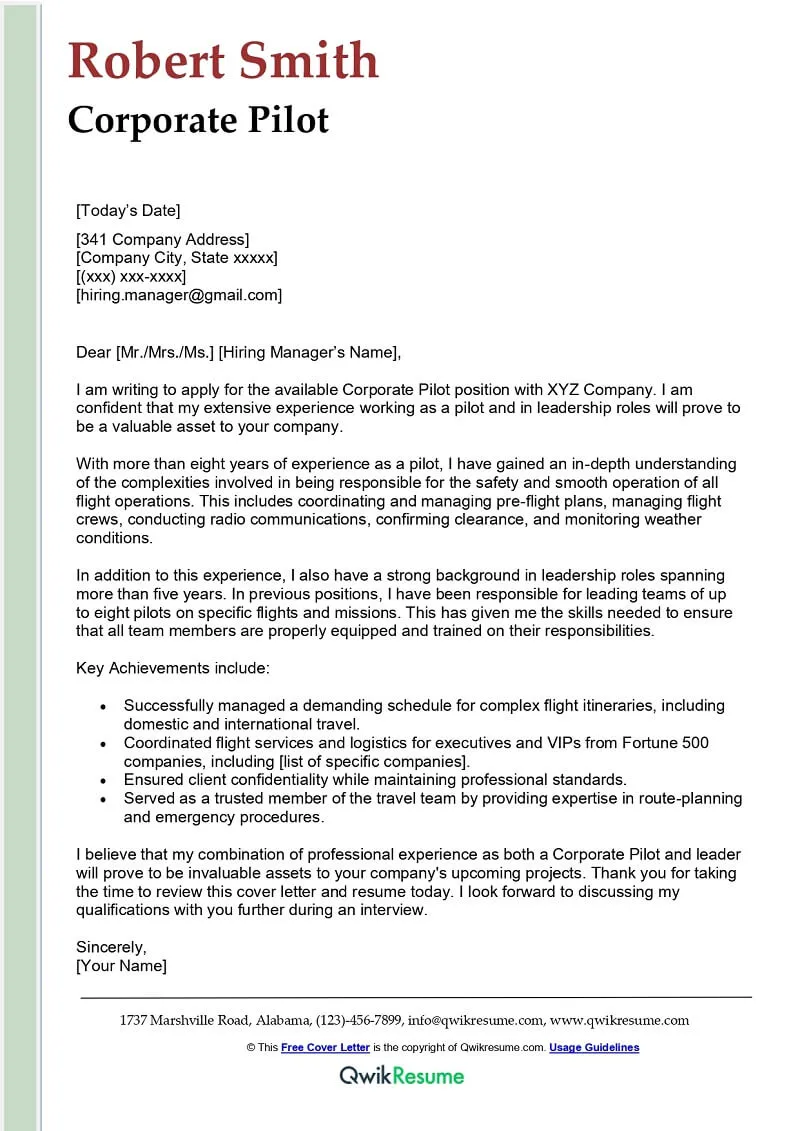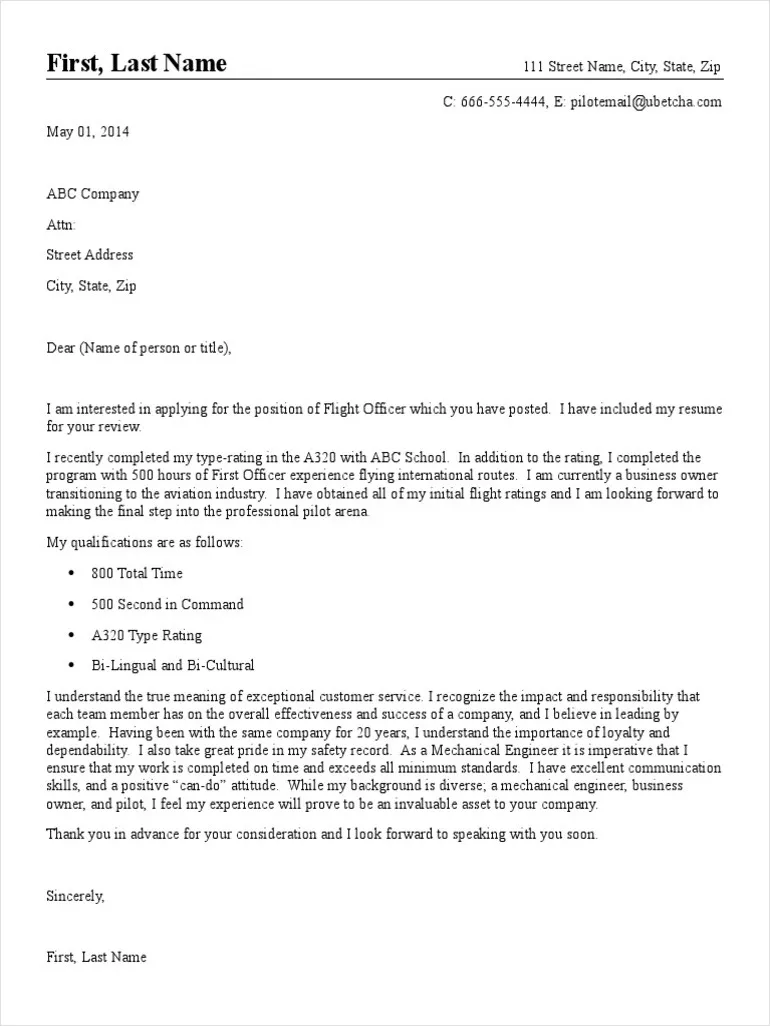Crafting the Perfect Pilot Cover Letter
A compelling cover letter is your first chance to impress a potential employer in the competitive world of aviation. It serves as your introduction, setting the tone for your application and highlighting your suitability for the pilot job. Crafting the perfect cover letter is not just about listing your qualifications; it’s about telling a story that showcases your passion for flying, your commitment to safety, and your unique skills. Start by researching the specific requirements of the job you’re applying for, as this will guide you in tailoring your letter. Make sure to address the letter to the hiring manager or the appropriate contact person, which demonstrates that you’ve taken the time to learn about the company and its needs. The opening paragraph should grab the reader’s attention and clearly state the position you’re applying for, immediately establishing your intent. Then, the body of your cover letter should expand on your key qualifications and experiences, providing evidence of your accomplishments and skills.
Highlighting Your Pilot Skills and Experience
Your cover letter is a great place to showcase your skills and experience that make you an exceptional pilot. Start by mentioning your flight hours, specifically those that are most relevant to the job you’re applying for such as time in specific aircraft types, or hours in complex environments. Highlight any specialized training, such as instrument flight rules (IFR), multi-engine ratings, or commercial licenses. Mention any experience you have in leadership roles or team management, because these skills are highly valued in aviation. Consider including any specific incidents or experiences that demonstrate your decision-making abilities, problem-solving skills, and commitment to safety. Remember to quantify your achievements whenever possible, such as the number of passengers flown, the improvement in fuel efficiency, or any safety records you maintained. Use action verbs like ‘managed,’ ‘coordinated,’ ’executed,’ and ‘piloted’ to describe your accomplishments, keeping the language precise and results-oriented. This helps to create a vivid picture of your skills and experience.
Pilot Licenses and Certifications Showcase

Your cover letter should clearly and concisely state your licenses and certifications. Begin by listing your current pilot licenses, such as an Airline Transport Pilot (ATP) certificate, a Commercial Pilot Certificate, or a Private Pilot Certificate. Be sure to include any ratings you hold, such as multi-engine, instrument, or seaplane. Then list other important certifications, like type ratings for specific aircraft, medical certifications, and any additional endorsements. Mention the issuing authority and the date of issue for each certificate, which adds to the credibility of your application. If you have any additional qualifications, such as a degree in aviation or related fields, note it here. Make sure that all of your certifications are current and valid, and indicate if you are working toward any additional qualifications. Keep the language direct and easy to understand, so that the hiring manager can quickly determine if you meet the minimum requirements for the job. This section should give the employer confidence in your professional credentials.
Cover Letter Formatting for Pilot Jobs
The formatting of your pilot cover letter is just as important as its content. Begin with your contact information at the top, including your name, address, phone number, and email address. Use a professional font like Times New Roman or Arial, and make sure the font size is easy to read. Use clear and concise language throughout the letter. Maintain a formal tone and avoid using slang or casual language. Break up the text into short paragraphs to improve readability. The layout should be clean and uncluttered, with consistent margins and spacing. Proofread the entire letter multiple times to catch any spelling or grammatical errors. The formatting should follow the standard business letter format, including the date, the hiring manager’s name and title, and the company’s address. Be sure to sign the letter at the end, if you’re sending a physical copy, and include your typed name below the signature. Ensure that the format is consistent and professional, as this shows that you pay attention to detail.
Tailoring Your Pilot Cover Letter for Specific Roles
Tailoring your cover letter for each job application is key to landing your dream job. Start by carefully reviewing the job description and identifying the key requirements and skills. Highlight the skills and experience that align with those requirements. Research the company and understand its values, mission, and culture. Customize your cover letter to address the company’s specific needs and demonstrate how your skills and experience can contribute to their success. Use the same language and keywords from the job description to show that you understand what the employer is looking for. Personalize the letter by mentioning specific projects or accomplishments that align with the role’s responsibilities. If possible, mention why you are interested in working for that specific company, demonstrating your genuine interest. This personalization shows that you have taken the time to understand the role and company, making your application stand out. A tailored cover letter will show potential employers you have invested the time and effort.
Key Pilot Achievements to Include

When highlighting your achievements, be sure to quantify your accomplishments whenever possible. Use specific data and metrics to demonstrate your success. Include specific examples of how you’ve improved safety, increased efficiency, or enhanced customer satisfaction. If you have received any awards or recognition, mention them to show your dedication to excellence. Include leadership experiences such as supervising flight crews or training new pilots, as these are valuable. Mention any special projects you’ve worked on, such as implementing new safety procedures or improving flight operations. Describe how you have handled challenging situations, such as emergency landings or adverse weather conditions. Highlight any instances where you have gone above and beyond to ensure safety and efficiency. Demonstrating specific achievements showcases your capabilities and gives the employer a clear picture of your past performance.
Essential Pilot Cover Letter Keywords
Using the right keywords in your cover letter is crucial for getting your application noticed. Review the job description to identify the key skills and qualifications that the employer is looking for. Incorporate these keywords naturally throughout your cover letter. Use keywords related to pilot skills, such as ‘flight planning,’ ’navigation,’ and ‘aircraft maintenance.’ Include aviation-specific terms like ‘IFR,’ ‘VFR,’ ‘MEL,’ and ‘FARs.’ Mention industry-specific software or systems you are familiar with. Use keywords that highlight your soft skills, such as ‘communication,’ ’leadership,’ and ‘problem-solving.’ Use synonyms for keywords to avoid sounding repetitive. Proofread your cover letter to ensure that all keywords are used correctly. Using the right keywords increases the chances of your cover letter being seen by hiring managers.
Cover Letter Mistakes Pilot Candidates Must Avoid
Avoiding common mistakes can significantly increase your chances of success. First, avoid generic cover letters; tailor each letter to the specific job and company. Ensure you do not make any spelling or grammatical errors, as this is crucial for making a good impression. Do not provide excessive details about your personal life that are not relevant to the job. Never be dishonest or exaggerate your skills and experience. Avoid using a negative tone or complaining about previous employers. Do not include too much jargon that the hiring manager may not understand. Make sure that you follow the instructions in the job posting. Always proofread your cover letter to avoid careless mistakes. Addressing these common mistakes will make you stand out.
